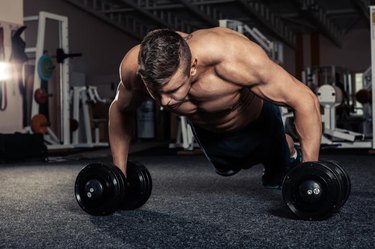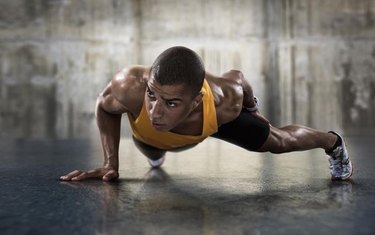
When it comes to push-ups versus pull-ups, it shouldn't be an either/or prospect. Both of the body-weight strength-training moves effectively works your upper body and core to create wide shoulders, a thick chest and ripped back. Each exercise targets a different area to provide a balanced look to your body.
Pull-Ups
Video of the Day
Your latissimus dorsi, a broad, long muscle that covers the backs of the ribs, middle back, rear shoulders, biceps, core and forearms, get a workout when you perform pull-ups.
Video of the Day

How To
Perform pull-ups by grasping a pull-up bar with a wide, overhand grip. Hang so that your legs dangle, and use your arms to pull your chin up and over the bar. Return to straight arms to complete one repetition. Avoid swinging or hitching your hips to increase momentum and get up more easily.
Push-Ups
Push-ups target your chest, triceps, shoulders and core.
How To
Get onto your hands and knees with your hands slightly wider than your shoulders and flat on the ground. Extend your legs behind you to create a straight torso. Brace your abdominals toward your spine for stability. Bend your elbows to lower your chest down toward the floor. Form a 45-degree angle with your elbows as you lower. Return to a high plank to complete one repetition.
Benefits
Both push-ups and pull-ups are low impact, so you can train often, with shorter periods of rest, as compared to when you train with heavy weights. The more you train, the greater your potential gains. You do risk overuse injuries if you use pull-ups and push-ups as your only training moves, however.
No other equipment is necessary to complete pull-ups or push-ups, save a pull-up bar. A door jam, tree branch or high piece of playground of equipment are places to find substitutes for a bar.

Both the pull-up and push-up are easily modified, too. Regress, or make the pull-up easier, by using a pull-up machine that supports some of your weight or have a spotter support your legs. Change your grip to alter the way the pull-up targets your back and shoulders; a narrow, underhand grip works your biceps more, while a wide, overhand grip is mostly about your lats.
Read More: Types of Pull-Up Exercises

Modify a push-up against a counter, wall or by supporting some of your weight on your knees. Add instability to amp up the challenge -- do push-ups off a stability ball, BOSU dome or with one leg lifted.
Round Out Your Workout
To fully develop your upper body, include additional exercises to train your back, chest and shoulders. For example:
Incline chest flyes: Lie on a workout bench placed at a 45-degree angle, hold a dumbbell in each hand with arms extended in front of your chest, and open and close your arms as if you were performing a hug.
Bent-over row: Grasp a barbell with an overhand grip with hands about shoulder-distance apart. From a stand with your feet hip-distance apart, soften your knee joints and hinge forward 45-degrees from your hips so the bar hangs just above your knees. Pull the bar to your belly button and release to complete on repetition.
Barbell chest press: Lie on a weight bench placed under a barbell rack. Unrack the bar by holding it with an overhand grip, hands a little wider than your shoulders. Bend your elbows to bring the bar to your chest; straighten your elbows to complete one rep.
Read More: Quickest Ways to Improve Pull-Ups